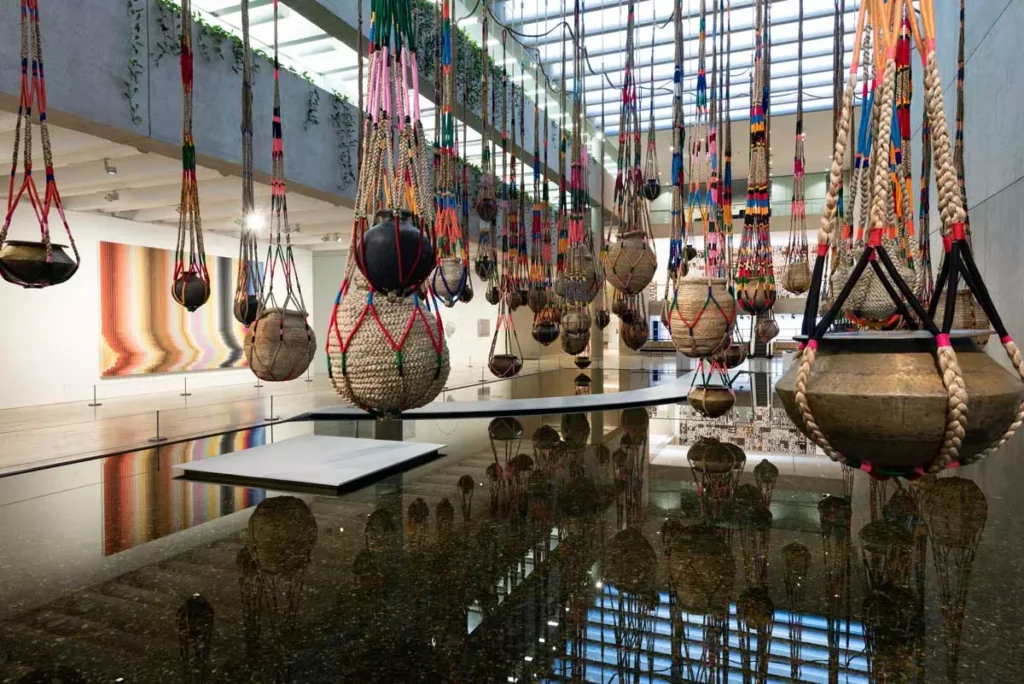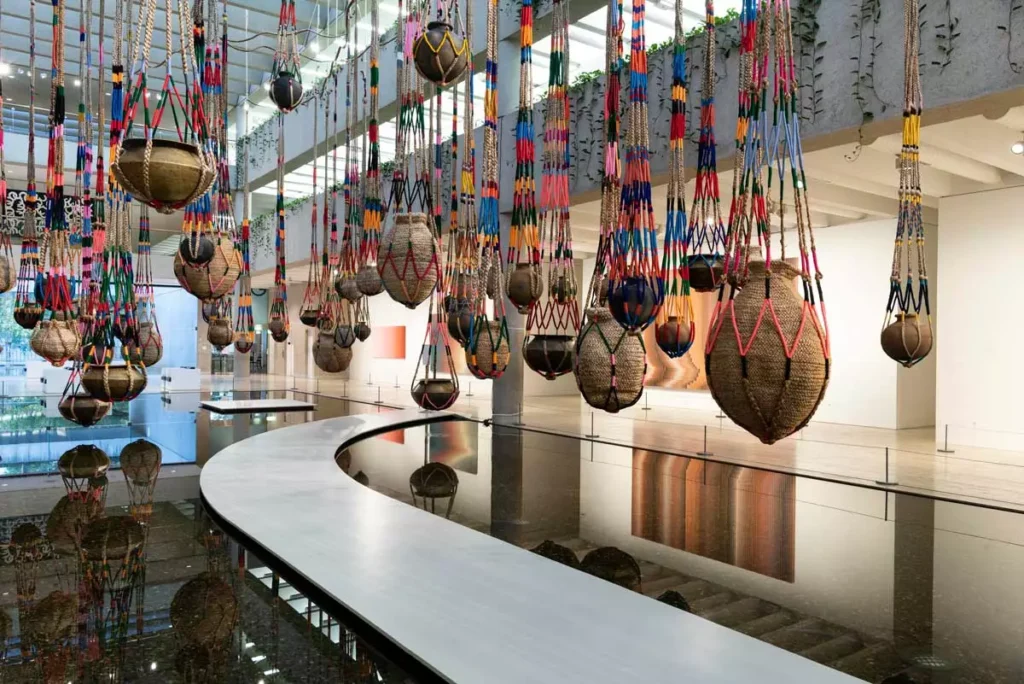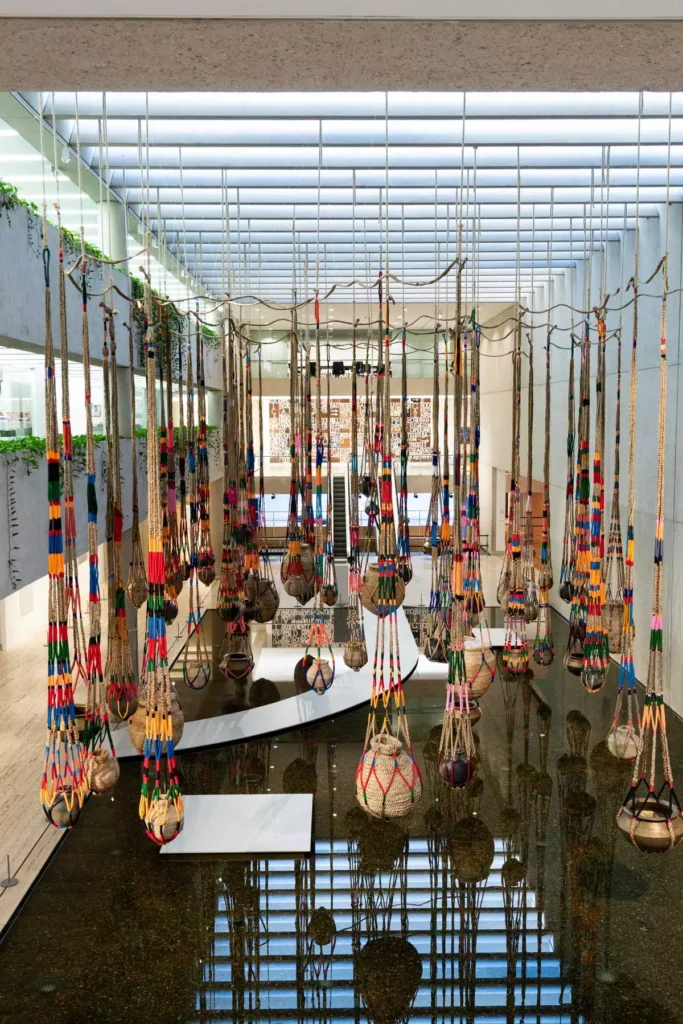Fibrous Souls
Communities of his home village of Balia in the far North-Western state of Thakurgaon. In 2001, he established Gidree Bawlee Foundation of Arts to work with the local indigenous Santhal communities. It seeks to be a catalyst for social inclusivity through collaborative approaches.
Kamruzzaman is also one of the Bangladesh’s foremost contemporary artists known for his installations and performances that address environmental and social issues, particularly those facing regional Bangladesh and its communities. Together with Gidree Bawlee, he produces ambitious, socially-driven contemporary art projects, driven by the principles of community development and exploring shared culture and histories.
The expansive installation The Fibrous Souls explores part of Bengal’s complex and pervasive colonial history through personal stories of movement and displacement. It is constructed with seventy giant shikas – embroidered, reticulated bags typically made of jute strings that are tied to a beam in the ceiling of houses and used to hold pots and food containers. Shikas were traditionally made by families, and are found in almost every house in rural Bangladesh and so designs, knotting and decoration varies between regions. The artwork articulates how a small part of the community came to settle in the surrounding villages. Stories that inspired the installation are drawn from families that had followed the route of the railways from what is now Bangladesh into India after the establishment of the Eastern Bengal Railway which operated under British India rule from 1892-1942. It was constructed by the British East India Company for the profiteering trade interests of British India, fuelled by locally produced commodities such as jute, indigo and opium. The domination of these cash crops led to food scarcity, debt and land loss, forcing people – such as the ancestors of the Thakurgaon jute makers – to turn away from farming their own lands. Families gradually left their homes to follow opportunities along the railway to Assam, however during the 1947 Partition of India, they found themselves divided from their homes by a new national border, only to be forced back over the border from India into what had become East Pakistan (present-day Bangladesh). They settled along the Brahmaputra River in the regions by the new border dividing Bengal. As this vast river continually eroded, their plight turned from political to ecological migration, slowly moving them westwards until they settled in Thakurgaon.
Working with 13 women hailing from the jute making families to construct the shikas, and a handful of other local craftspeople to create the pots and connecting jute ropes, Kamruzzaman and Gidree Bawlee have constructed a giant hanging system of shikas, laid out as the map of the historic Eastern Bengal Railway which began this story. The women created their own designs on the shikas, so each is unique and features various wrapping and knotting techniques and additional decoration. The shikas suspend brass, jute and clay storage pots, which are suspended over water for APT10. The hanging pots each symbolise the stations of towns and cities on the railway map – from Calcutta (now Kolkata) and Chittagong (now Chattogram) in the South, to Darjeeling and Guwahati in the North – signifying the defining role this piece of colonial infrastructure has played in shaping their lives. In Shadhin’s words, the installation ‘is an attempt to interweave these historical and cultural strands that seem apparently and innocently disconnected; and connect these to the present day peasant conditions in Assam and Bengal’.
The project draws together members of communities to explore their own stories and cultural practices, and is a product of the unique practice Kamruzzaman and Gidree Bawlee have developed. Imbued with local and social values, it is a practice that advocates and finds new pathways for contemporary art in regional communities who are not reliant on art centres or global arts discourse, revealing new possibilities for art production to audiences far from where they emerge.
* Gidree Bawlee continues to be run by Kamruzzaman and Salma Jamal Moushum to develop pathways for cultural and artistic exchange including artist residencies, art workshops, children’s puppet theatre, and supporting crafts industries and cultural festivals.
Tarun Nagesh
Kamruzzaman Shadhin and Gidree Bawlee Foundation of Arts
2018-2021
Dhaka Art Summmit, 2020.
10th Asia Pacific Triennial of Contemporary Art, Queensland Art Gallery and Museum of Modern Art, Brisbane.
Collaborating artisans: Johura Begum, Monowara Begum, Majeda begum, Fatema begum (1), Shabnur Begum, Chayna Begum, Fatema Begum (2), Samiron Begum, Shirina Begum, Rekha, Nasima Begum, Shushila Rani, Protima Rani, Akalu Barman




